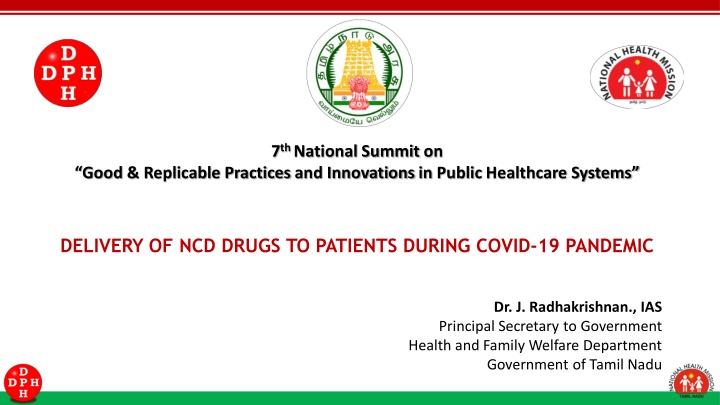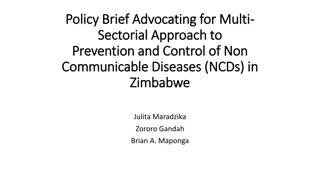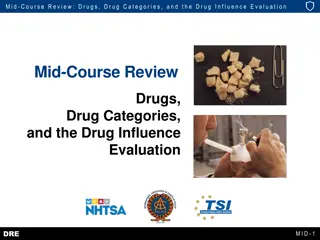Innovative Approach to Delivering NCD Drugs During COVID-19 Pandemic in Tamil Nadu
Covid-19 posed challenges to delivering NCD drugs, especially to those with comorbidities. Tamil Nadu implemented proactive measures such as cocooning the vulnerable and providing two months' worth of NCD drugs to ensure uninterrupted supply. Various committees and volunteers collaborated to educate and support NCD patients and their families during the pandemic.
Download Presentation

Please find below an Image/Link to download the presentation.
The content on the website is provided AS IS for your information and personal use only. It may not be sold, licensed, or shared on other websites without obtaining consent from the author.If you encounter any issues during the download, it is possible that the publisher has removed the file from their server.
You are allowed to download the files provided on this website for personal or commercial use, subject to the condition that they are used lawfully. All files are the property of their respective owners.
The content on the website is provided AS IS for your information and personal use only. It may not be sold, licensed, or shared on other websites without obtaining consent from the author.
E N D
Presentation Transcript
7th National Summit on Good & Replicable Practices and Innovations in Public Healthcare Systems DELIVERY OF NCD DRUGS TO PATIENTS DURING COVID-19 PANDEMIC Dr. J. Radhakrishnan., IAS Principal Secretary to Government Health and Family Welfare Department Government of Tamil Nadu
INTRODUCTION Covid-19 is a communicable disease which swept all over the world resulting in morbidity and mortality. According to the WHO report, mortality is high among those with comorbidities like Diabetes Mellitus, Hypertension, Chronic kidney disease and Cancer. During Covid-19 Pandemic, Health Services for providing Non- communicable disease drugs in the routine way got hindered due to complete lockdown. Tamil Nadu came forth with suitable innovation to overcome this hurdle and reach the drugs at patients door steps.
TAMIL NADU - AGE SPECIFIC COVID DEATHS (n=12166) Age Group 0-10 11-20 21-30 31-40 41-50 51-60 61-70 71-80 81-90 90 Plus Total No. of Death 12 23 140 455 1173 2766 3713 2723 1044 117 12166 35, 0.3% 595, 4.9% 3939, 32.4% 7597, 62.4% 0-20 21-40 41-60 >60
CO-MORBIDITY AMONG THE DEATH CASES (N=12166) Number of cases(%) Co-morbid conditions 0-20 (%) 21-40 (%) 41-60 (%) Above 60 (%) Diabetes and Hypertension 33% 0 0 10 23 18% Only Diabetes 24% 0 1 9 14 Only Hypertension 14% 0 1 4 9 82% Other co- morbidity 11% 0 1 4 6 No- comorbidity 18% 0 2 6 10 Co-morbidity No-comorbidity Total 100% 0 5 33 62
PROACTIVE CARE OF ELDERLY & PEOPLE WITH CO-MORBIDITY Cocooning of vulnerable was the strategy focused 12 Expert Committees were formed to frame specific guidelines for health care providers Two months dose of NCD drugs were dispensed for all NCD patients Women Self Help Group members, Volunteers, staff contacted line-listed NCD patients and their families for educating on special precautions to be taken during Covid-19. Women Health Volunteers (WHVs), ASHAs, with the support of field staff, carried out regular surveillance of elderly and NCD patients to address their medical problems. Palliative Care team
RATIONALE During the complete lockdown, there was practically no transport service for the patients to reach health care facilities. This, if not addressed, would have resulted in poor drug compliance and worsening of the disease condition. Since Covid-19 morbidity and mortality is high among those with co-morbidities there was absolute need to maintain uninterupted supply of NCD drugs. Hence Tamil Nadu took up certain innovative measures to deliver the services through an organised network system.
TN MODEL OF DRUG DELIVERY Two delivered for all NCD patients registered at Primary, Secondary Health care facilities through Multiple decentralised mechanisms. months of NCD drugs were and Tertiary Priority was given to NCD patients under specific categories such as those in the Geriatric Age group, Home bound and requiring palliation.
TN MODEL OF DRUG DELIVERY Line-list of all NCD Patients were made available at Sub Centres and HWCs Among them, a high priority list of NCD patients was made ready Palliative care patients Bed Ridden and sick patients with NCD Geriatric Patients with complications Others needing special care (as listed by Community Volunteers) The patient whose contact numbers were not available in the registration details were traced and identified through Women Health Volunteers/Public Health field staff
TN MODEL OF DRUG DELIVERY Drugs were distributed to them at the doorsteps through Village Health Nurses, Mobile Medical Unit, RBSK teams, Women Health Volunteers (WHVs) and other volunteers identified in the community. Proper personal protective measures and social distancing were observed while distributing the drugs at the doorstep. Women Health Volunteers at HWCs played a pivotal role in screening of complications also TNMSC played a key uninterrupted drug supply No event / news on drug shortage was reported from any source including media. role in ensuring
HUMAN RESOURCES For this model, the following human resource were utilised: Village Health Nurse (VHNs) Mobile Medical Unit (MMUs) RBSK team Women Health Volunteers (WHVs) Other volunteers are utilized to provide NCD service
EVIDENCE OF EFFECTIVENESS The number of patients benefited (April to May 2020): DM HT HT & DM No. of Hyperte nsion patients for whom 2 months drugs were issued No. of Diabetes Mellitus patients for whom 2 months of drugs were issued Total Number of Diabetes Mellitus & Hyperten sion Patients Total No. of NCD patients who received 2 months of drugs No. of Diabetes Mellitus & Hypertension patients for whom 2 months drugs were issued Total Number of line- listed Diabetes Mellitus Patients Total Number of line- listed Hyperten sion Patients Total No of line- listed NCD Patients % of Drug Issued % of Drug Issued % of Drug Issued % of Drug Issued (a+c+e) (b+d+f) (a) (b) (c) (d) (e) (f) 7,30,339 5,37,977 73.7 11,73,321 8,36,770 71.3 4,80,908 3,47,364 72.2 23,84,568 17,22,111 72.2 72.2% of registered NCD patients received drugs through volunteers or field staff at their doorstep during COVID 19 lockdown.
COST-EFFECTIVENESS For this model, National Health Mission engaged the existing human resources like Village Health Nurses, Women Health Volunteers, teams working in Mobile Medical Unit and RBSK teams were utilised to distribute the NCD Drugs to the doorsteps of the patients based on the line-list. In addition to that, a portal for volunteers was created at the State Level. Volunteers registered were also utilized by the local District Administrations to deliver drugs at the doorsteps of the NCD patients. MMUs and RBSK vehicles were utilized for mobility in the above model. Hence the cost for separate vehicles for transportation was not required. Thus, the State was able to effectively deliver drugs at the doorstep of NCD patients in a cost- effective manner.
LESSONS AND CHALLENGES Covid19 pandemic has showed that we should have alternate viable plan for providing Health care services to the most vulnerable population. Existing field level functionaries and other community volunteer services were aptly used for providing healthcare services to the needy population. Decentralized planning of drug delivery is the key for NCD control in future through dedicated community volunteers
POTENTIAL FOR SCALE Delivery of drugs at the doorstep is a novel idea which can be utilized in future during any form of disasters including natural calamity. Cost-effective Dedicated Trained Community Volunteers ready at-hand work force in the community. This Model can be implemented on a larger scale in future because it doesn t involve extra human resources and it is also an effective way to reach people. A centralised drug procurement and logistics agency like TNMSC is also the backbone for the success of this innovative practice.
PARTNERS IN IMPLEMENTATION WITH NHM Tamilnadu Medical Services Corporation Directorate of Public Health and Preventive Medicine TNCDW Self Help Group network. Volunteers in the community























